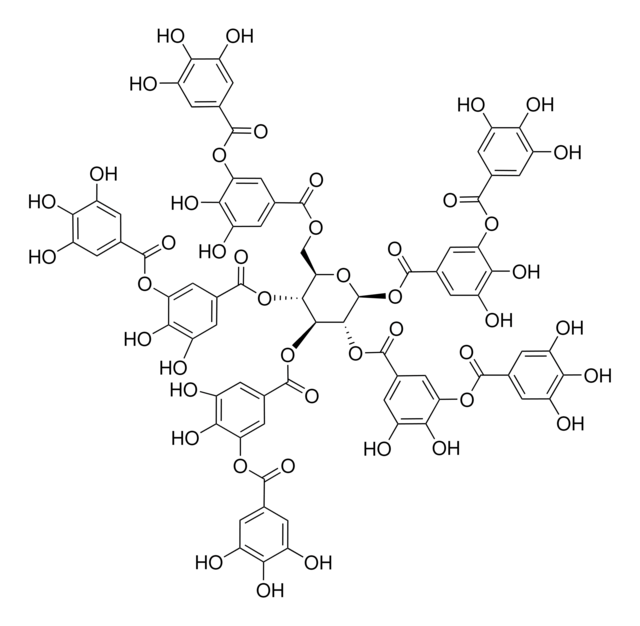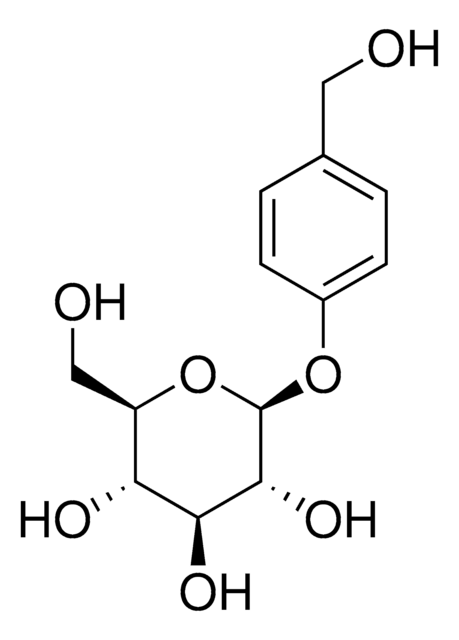16201
Tannic acid
puriss., powder
Sinônimo(s):
Gallotannin, Tannin
About This Item
Produtos recomendados
grau
puriss.
Formulário
powder
temperatura de autoignição
980 °F
qualidade
meets analytical specification of USP
Impurezas
dextrines, gum matters, in accordance
resinous matters, in accordance
resíduo de ignição
≤0.1% (as SO4)
perda
≤9% loss on drying, 105 °C, 2 h
pf
218 °C (lit.)
solubilidade
H2O: soluble 1 gm in 0.35ml
glycerol: soluble 1gm in 1 ml (warm)
acetone: very soluble
alcohol: freely soluble (Diluted)
alcohol: slightly soluble (Dehydrated)
alcohol: very soluble
benzene: insoluble
carbon disulfide: insoluble
carbon tetrachloride: insoluble
chloroform: insoluble
diethyl ether: insoluble
hexane: insoluble
petroleum ether: insoluble
aplicação(ões)
metabolomics
vitamins, nutraceuticals, and natural products
cadeia de caracteres SMILES
Oc1cc(cc(O)c1O)C(=O)Oc2cc(cc(O)c2O)C(=O)OC[C@H]3O[C@@H](OC(=O)c4cc(O)c(O)c(OC(=O)c5cc(O)c(O)c(O)c5)c4)[C@H](OC(=O)c6cc(O)c(O)c(OC(=O)c7cc(O)c(O)c(O)c7)c6)[C@@H](OC(=O)c8cc(O)c(O)c(OC(=O)c9cc(O)c(O)c(O)c9)c8)[C@@H]3OC(=O)c%10cc(O)c(O)c(OC(=O)c%11cc(O)c(O)c(O)c%11)c%10
InChI
1S/C76H52O46/c77-32-1-22(2-33(78)53(32)92)67(103)113-47-16-27(11-42(87)58(47)97)66(102)112-21-52-63(119-72(108)28-12-43(88)59(98)48(17-28)114-68(104)23-3-34(79)54(93)35(80)4-23)64(120-73(109)29-13-44(89)60(99)49(18-29)115-69(105)24-5-36(81)55(94)37(82)6-24)65(121-74(110)30-14-45(90)61(100)50(19-30)116-70(106)25-7-38(83)56(95)39(84)8-25)76(118-52)122-75(111)31-15-46(91)62(101)51(20-31)117-71(107)26-9-40(85)57(96)41(86)10-26/h1-20,52,63-65,76-101H,21H2/t52-,63-,64+,65-,76+/m1/s1
chave InChI
LRBQNJMCXXYXIU-PPKXGCFTSA-N
Procurando produtos similares? Visita Guia de comparação de produtos
Descrição geral
Aplicação
- as a reference standard to measure the total hydrolyzable tannins in Oak root bark tannin-methanol extract using a UV/Vis spectrophotometer
- as a blood-brain barrier (BBB) impermeable, transcytosis-inhibiting drug in spheroid culture medium
- as a flushing agent to test its effects on metal ions, total organic carbon, and organic matter of soil
- as an inhibitor of free ovalbumin (OVA) uptake by the endocytic mechanism on dendritic cells
Ações bioquímicas/fisiológicas
Código de classe de armazenamento
11 - Combustible Solids
Classe de risco de água (WGK)
WGK 2
Ponto de fulgor (°F)
390.2 °F
Ponto de fulgor (°C)
199 °C
Escolha uma das versões mais recentes:
Já possui este produto?
Encontre a documentação dos produtos que você adquiriu recentemente na biblioteca de documentos.
Os clientes também visualizaram
Nossa equipe de cientistas tem experiência em todas as áreas de pesquisa, incluindo Life Sciences, ciência de materiais, síntese química, cromatografia, química analítica e muitas outras.
Entre em contato com a assistência técnica






